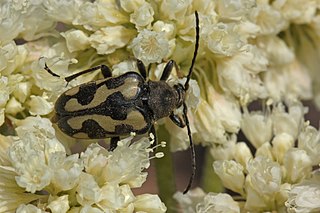
Lepturinae, the lepturine beetles, is a subfamily of the longhorn beetle family (Cerambycidae), containing about 150 genera worldwide. This lineage is most diverse in the Northern Hemisphere. Until recently the subfamily Necydalinae was included within the lepturines, but this has been recently recognized as a separate subfamily. Nine tribes are usually recognized today, with a tenth, Caraphiini, created in 2016. A few genera are of uncertain placement within the subfamily.

Xestoleptura is a genus of flower longhorn beetles in the family Cerambycidae.

Stenocorus is a genus of beetles in the family Cerambycidae, containing the following species:

Neoclytus is a genus of beetles in the family Cerambycidae. They measure 4-20 mm. There are 93 species in the New World.
Aneflomorpha is a genus of beetles in the family Cerambycidae, containing the following species:

Trachyderini is a tribe of long-horned beetles in the family Cerambycidae. There are at least 140 genera and 650 described species in Trachyderini.

Crossidius is a genus of beetles in the family Cerambycidae.
Elytroleptus is a genus of beetles in the family Cerambycidae, containing the following species:

Pogonocherini is a tribe of longhorn beetles of the subfamily Lamiinae.
Judolia antecurrens is an extinct species of beetle in the family Cerambycidae. It was described by Wickham in 1913.

Pachytodes erraticus , or Judolia erratica, is a species of beetle in the family Cerambycidae. It was described by Johan Wilhelm Dalman in 1817. Their body length ranges from 7 - 12mm. They live in underground parts of deciduous trees
Judolia impura is a species of beetle in the family Cerambycidae. It was described by John Lawrence LeConte in 1857.

Judolia instabilis is a species of beetle in the family Cerambycidae. It was described by Haldeman in 1847. Their appearance ranges from black with yellow spots to full black in color. They range in size from 6 mm to 15 mm in length. They inhabit the U.S and Canada.
Judolia orthotricha is a species of beetle in the family Cerambycidae. It was described by Plavilstshikov in 1936.
Judolia quadrata is a species of beetle in the family Cerambycidae. It was described by John Lawrence LeConte in 1873.
Judolia scapularis is a species of beetle in the family Cerambycidae. It was described by Van Dyke in 1920.

Judolia sexmaculata is a species of beetle in the family Cerambycidae. It was described by Carl Linnaeus in his landmark 1758 10th edition of Systema Naturae.
Judolia sexspilota is a species of beetle in the family Cerambycidae. It was described by John Lawrence LeConte in 1859.

Lepturini is a tribe of flower longhorns in the family Cerambycidae.











